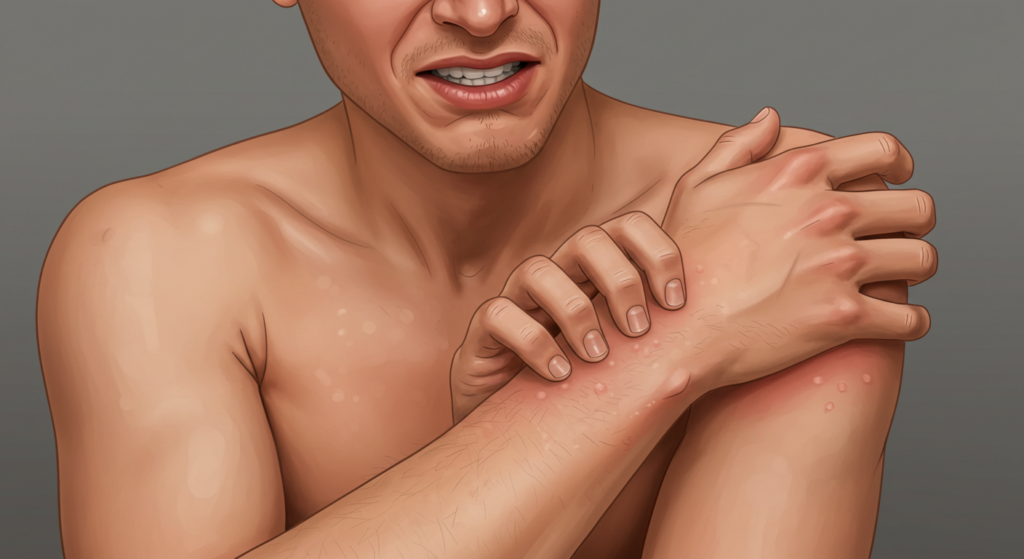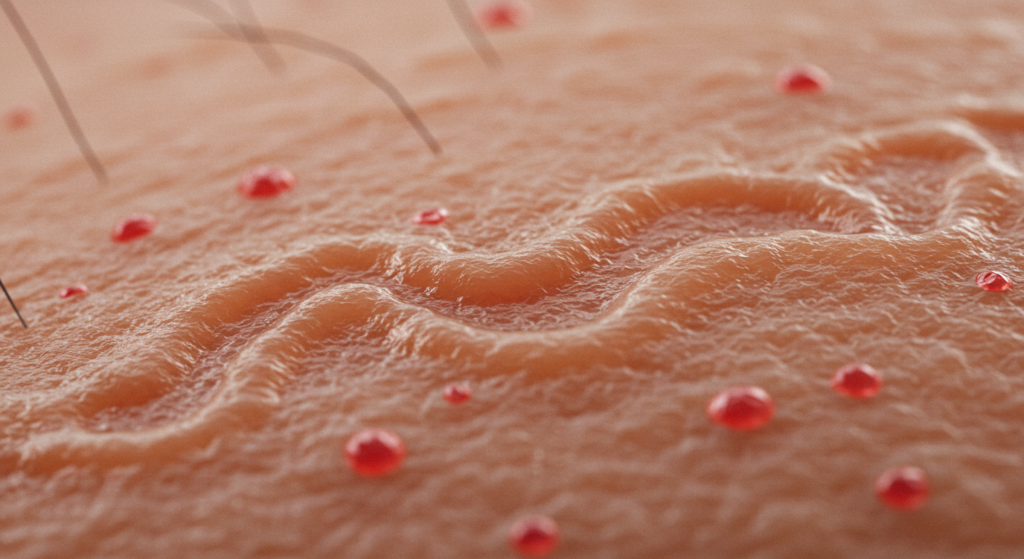La sarna, una infestación cutánea altamente contagiosa causada por Sarcoptes scabiei El ácaro afecta a millones de personas en todo el mundo. Comprender sus síntomas, transmisión, tratamiento y prevención es crucial para un manejo y control eficaces. Este artículo ofrece una visión general de esta afección común, aunque a menudo malinterpretada.

Comprender los síntomas de la sarna
La sarna se presenta con una erupción característica con picazón intensa. Esta picazón suele empeorar por la noche y puede ser grave, afectando significativamente el sueño y la calidad de vida. La erupción en sí no es uniforme; suele aparecer como pequeñas protuberancias o ampollas similares a granos, a menudo en grupos o líneas. Estas lesiones son causadas por la actividad de excavación del ácaro bajo la piel.
Un síntoma común, aunque no universal, es la presencia de surcos. Se trata de líneas delgadas y ligeramente elevadas en la piel, a menudo con un pequeño punto negro al final: se trata del propio ácaro o de sus heces. Los surcos se encuentran con mayor frecuencia entre los dedos, en las muñecas, la parte interna de los codos, las axilas y alrededor de los genitales y las nalgas. Sin embargo, en bebés y niños pequeños, la erupción puede extenderse al cuero cabelludo, las palmas de las manos y las plantas de los pies.
Las infecciones cutáneas secundarias son una complicación común de la sarna. El rascado intenso causado por la picazón puede dañar la piel y provocar infecciones bacterianas. Estas infecciones pueden manifestarse como llagas supurantes, formación de costras y aumento del dolor y la inflamación. Es importante tener en cuenta que la intensidad de los síntomas puede variar considerablemente entre personas.
Algunas personas pueden experimentar una reacción tardía a la infestación inicial, lo que significa que los síntomas podrían no aparecer hasta varias semanas después de la exposición. Este retraso hace que sea crucial considerar la posibilidad de sarna en casos de picazón intensa sin causa aparente, especialmente si afecta a varios miembros de la familia o a contactos cercanos.

Vías de transmisión de la sarna
La sarna se transmite principalmente por contacto directo y prolongado con una persona infestada. Este contacto cercano permite que los ácaros se transmitan fácilmente de una persona a otra. Los ácaros no pueden saltar ni volar, por lo que la transmisión suele ocurrir por proximidad física, como abrazos, caricias o contacto sexual.
La transmisión indirecta es menos común, pero aún posible. Puede ocurrir por contacto con artículos contaminados, como ropa de cama, prendas de vestir o toallas, que hayan estado en contacto reciente con una persona infestada. Sin embargo, los ácaros no pueden sobrevivir largos periodos lejos de un huésped humano, generalmente solo unos días como máximo. Por lo tanto, la transmisión indirecta es menos probable, a menos que los artículos estén muy contaminados y se hayan usado recientemente.
Las condiciones de vida superpobladas aumentan el riesgo de transmisión de sarna. En entornos como albergues o residencias de ancianos, donde el contacto cercano es frecuente y las prácticas de higiene pueden verse comprometidas, es más probable que se produzcan brotes. Asimismo, las familias y las personas que viven cerca corren un mayor riesgo de propagar la infestación.
Comprender las vías de transmisión es crucial para una prevención eficaz. Identificar y tratar a las personas infestadas con prontitud, junto con prácticas de higiene rigurosas y el lavado adecuado de los artículos potencialmente contaminados, son pasos clave para controlar la propagación de la sarna.
Opciones efectivas de tratamiento para la sarna
El tratamiento principal para la sarna son los medicamentos tópicos, específicamente los escabicidas. Estos medicamentos eliminan los ácaros y están disponibles en diversas presentaciones, como cremas y lociones. La crema de permetrina es un escabicida de uso común y muy eficaz, que se aplica en todo el cuerpo, desde el cuello hacia abajo. Es fundamental seguir las instrucciones cuidadosamente, asegurando una cobertura completa y dejando actuar el medicamento durante el tiempo prescrito.
Otro escabicida eficaz es la loción de lindano. Sin embargo, su uso es cada vez menos común debido a su posible neurotoxicidad. El lindano solo debe usarse bajo estricta supervisión médica y generalmente se reserva para casos en los que la permetrina es ineficaz o está contraindicada. La ivermectina, un medicamento oral, se utiliza a veces en casos de sarna costrosa, una forma más grave de la infestación, o cuando los tratamientos tópicos fracasan.
El tratamiento debe aplicarse a todos los miembros de la familia y contactos cercanos, incluso si son asintomáticos. Esto se debe a que las personas pueden estar infestadas sin presentar síntomas. También es fundamental limpiar y lavar a fondo toda la ropa de cama, la ropa y las toallas utilizadas por la persona infestada para prevenir la reinfestación.
Aunque el tratamiento suele resolver la infestación, puede persistir algo de picazón durante varias semanas después del tratamiento. Esto se debe a la respuesta inflamatoria del cuerpo a los ácaros y sus desechos. Los antihistamínicos u otros medicamentos contra la picazón pueden ayudar a controlar esta picazón posterior al tratamiento.
Prevención de la infestación por sarna
Mantener una buena higiene es una medida preventiva clave. Ducharse y lavarse con agua y jabón regularmente puede ayudar a reducir el riesgo de infestación. Sin embargo, es importante recordar que la sarna no se debe a una mala higiene; es una afección altamente contagiosa que puede afectar a cualquier persona.
Es fundamental evitar el contacto directo y prolongado con personas que puedan estar infestadas. Esto es especialmente importante en entornos donde los brotes de sarna son más frecuentes, como albergues o residencias de ancianos. En estos entornos, las pruebas de detección periódicas y el tratamiento inmediato pueden ayudar a prevenir brotes generalizados.
El lavado adecuado de la ropa, la ropa de cama y las toallas es fundamental. Las prendas deben lavarse con agua caliente (al menos a 54 °C) y secarse en secadora a alta temperatura durante al menos 20 minutos para eliminar cualquier posible ácaro. También se pueden limpiar en seco.
Inspeccionarse la piel regularmente para detectar cualquier signo de sarna, como picazón intensa o una erupción cutánea característica, puede ayudar a la detección temprana y al tratamiento. La intervención temprana es crucial para minimizar la propagación de la infestación y prevenir complicaciones.
La sarna es una enfermedad tratable, pero el diagnóstico y el tratamiento oportunos son esenciales para prevenir su propagación y minimizar su impacto en las personas y las comunidades. Al comprender sus síntomas, vías de transmisión, opciones de tratamiento y estrategias de prevención, podemos controlar eficazmente esta infestación parasitaria común. Si sospecha que usted o un ser querido puede tener sarna, consulte a un profesional de la salud para obtener un diagnóstico y tratamiento adecuados.
Descubra la experiencia de la Dra. Ebru Okyay, su médico de confianza. dermatólogo en AntalyaYa sea que esté buscando abordar problemas médicos de la piel o mejorar su belleza natural con tratamientos cosméticos, el Dr. Okyay está aquí para ayudarlo. Con atención personalizada y técnicas avanzadas, lograr sus objetivos para la piel nunca ha sido tan fácil.
